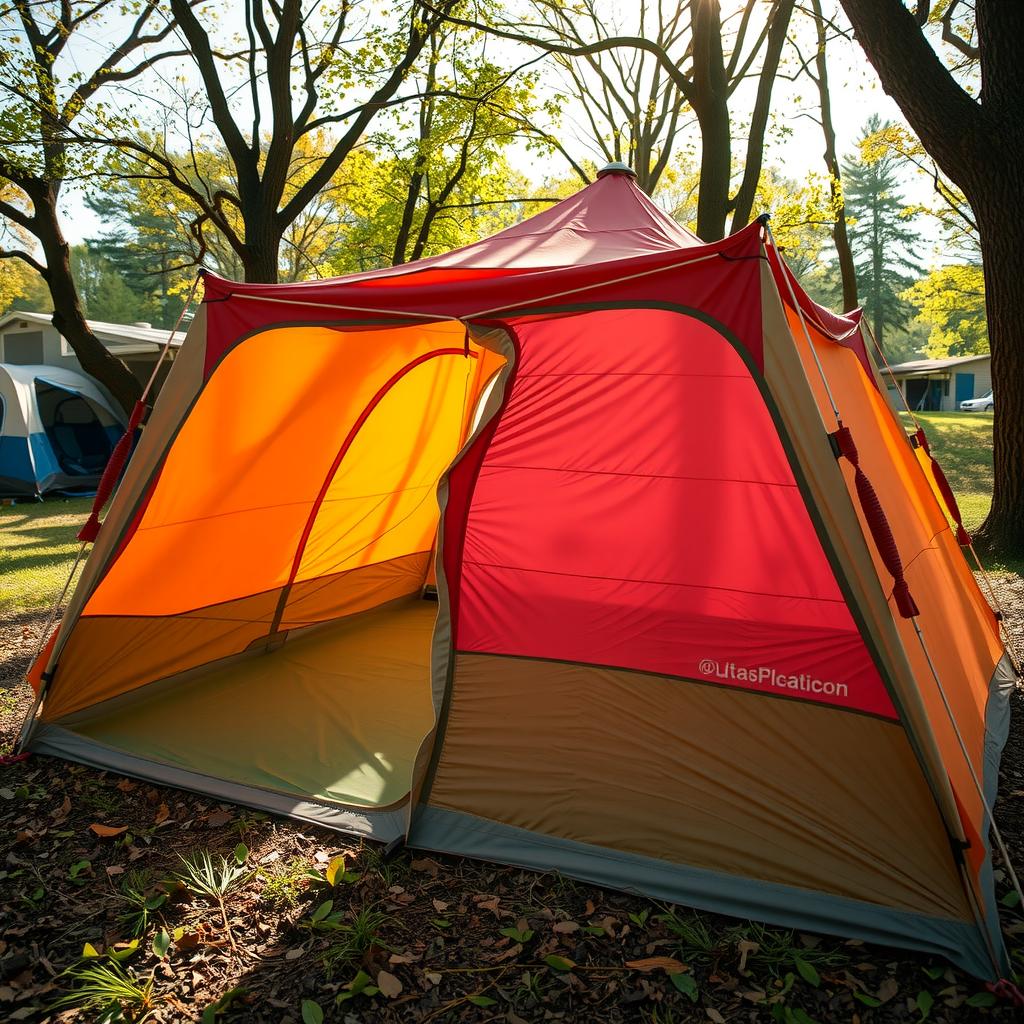When planning an outdoor adventure, whether it’s a weekend camping trip or an extended hike, one of the most crucial yet often overlooked elements is the tent’s footprint material. Many campers and outdoor enthusiasts focus on selecting the perfect custom size tent but may neglect to consider how vital a high-quality footprint can be for ensuring comfort and protection. This oversight can lead to unpleasant experiences when faced with unpredictable weather conditions or rough terrains. In today’s guide, readers will explore various options regarding footprint materials that not only enhance durability but also offer superior weather protection.
The core value of this article lies in its comprehensive approach to educating readers about the different types of materials available for custom tent footprints and how these choices impact their overall camping experience. By understanding various footprint material options—from lightweight fabrics ideal for backpacking trips to more robust solutions suited for family outings—adventurers can make informed decisions that align with their specific needs.
Moreover, this guide provides insights into selecting appropriate size options tailored to individual tents while emphasizing factors such as weight, portability, and ease of use. With proper knowledge at hand, outdoor enthusiasts can confidently select durable materials that serve as effective ground covers beneath their tents. Ultimately, investing in quality footprint material is essential not just for protecting one’s gear but also for enhancing comfort during those long nights spent under the stars.
As we delve deeper into this informative exploration of custom size tent footprint materials, readers will discover practical solutions tailored specifically to ensure they are well-prepared for any terrain or weather condition they might encounter on their journeys. So buckle up; this detailed tent guide promises valuable insights that could transform your next camping experience!

Key Takeaways: Understanding the Essentials of Footprint Materials for Custom Size Tents
When embarking on an outdoor adventure, selecting the right footprint material for a custom size tent is often overlooked but essential. This guide highlights several key aspects that will aid in making an informed decision.
1. Material Durability: The Backbone of Outdoor Shelters
Choosing durable materials significantly affects the longevity and overall performance of your custom tent. High-quality footprint materials can withstand wear-and-tear from sharp objects or abrasive terrains, ensuring that your camping gear remains intact throughout your journey. For instance, heavy-duty nylon or polyethylene options offer excellent puncture resistance, providing peace of mind when setting up camp in rugged locations.
2. Weather Protection: Shielding Against Nature’s Elements
Effective weather protection is paramount for any outdoor experience, particularly with a custom size tent tailored to personal needs. Water-resistant footprint materials act as barriers against moisture from the ground during rainy conditions, keeping you dry and comfortable inside your shelter. Additionally, certain fabrics are designed to enhance breathability while offering superior insulation against cold temperatures—a critical factor that contributes to a pleasant night under the stars.
3. Weight and Portability: A Balance Between Functionality and Convenience
For adventurers who prioritize mobility, evaluating weight options among various footprint materials is crucial when choosing a custom tent configuration suitable for their style of camping. Lightweight yet sturdy alternatives allow ease in packing without compromising on durability—ensuring that campers do not have to sacrifice comfort for convenience during their travels.
In conclusion, understanding these factors will empower outdoor enthusiasts to select the perfect footprint material tailored specifically to their custom needs when utilizing a custom size tent, enhancing both functionality and enjoyment in every camping experience.

Introduction to Footprint Material
Enhancing Comfort in Custom Size Tents
The choice of footprint material plays a crucial role in the overall experience of using a custom size tent. A well-selected footprint not only provides added comfort but also significantly enhances protection against various outdoor elements. When setting up an outdoor shelter, it’s essential to consider how durable materials can serve as effective ground cover, safeguarding the tent from abrasions and moisture. This protective layer acts as a barrier between the tent floor and the potentially harsh terrain underneath, ensuring that users remain dry and comfortable throughout their camping adventure. Investing in high-quality footprint material tailored for specific size options allows campers to enjoy their time outdoors without concerns over wear and tear or weather-related issues.
The Role of Durable Materials
Ensuring Weather Protection for Your Tent
In any camping situation, having reliable weather protection is paramount—especially when utilizing a custom size tent designed for unique needs. The right footprint material contributes significantly to this aspect by providing an additional shield against rain, snow, and other environmental challenges. For instance, waterproof footprints help prevent water from seeping into the base of the tent during heavy downpours while simultaneously offering insulation from cold ground temperatures. By selecting suitable materials specifically engineered for durability and resistance, campers can ensure that their outdoor gear remains intact despite exposure to varying conditions over time.
Choosing Your Ideal Ground Cover
Navigating Size Options for Optimal Performance
Selecting the appropriate ground cover is integral when using a custom size tent, as it directly impacts both functionality and comfort levels during use. Campers should carefully evaluate available size options along with their intended application before making decisions about footprint materials. A properly fitted ground cover will enhance stability while minimizing movement within the sleeping area—ideal for those seeking restful nights amidst nature’s backdrop. Furthermore, understanding different types of footprints on offer enables users to tailor their choices based on specific environments they plan to explore; whether hiking through forests or setting up camp near lakeshores ensures that every outing maximizes enjoyment while maintaining essential protections.
Types of Footprint Materials: Evaluating Your Options
A Comprehensive Guide to Choosing the Right Footprint Material
When selecting a footprint material for your custom size tent, it is essential to consider factors such as durability, water resistance, and puncture protection. Various materials offer distinct advantages. For instance, heavy-duty polyethylene provides excellent durability against wear and tear while ensuring effective weather protection. This makes it a popular choice among outdoor enthusiasts seeking reliable ground cover for their outdoor shelter needs. Additionally, nylon footprints are lightweight and packable yet maintain impressive water resistance—ideal for those who prioritize portability in their camping gear. Moreover, thicker materials like canvas can provide superior puncture protection but may be heavier to carry on trips requiring more mobility. Ultimately, understanding the specific qualities of each footprint material allows campers to make informed decisions tailored to their unique requirements while maximizing the longevity of their custom tents in various environments.
Factors to Consider When Choosing a Footprint
Essential Aspects for Camping Comfort
Choosing the right footprint is crucial for enhancing one’s camping experience, particularly when using a custom size tent. Weight plays a significant role; lighter footprints facilitate easier transport and setup, making them ideal for backpackers who prioritize mobility. Additionally, ease of setup cannot be overlooked—opt for footprints that allow quick assembly, as this can greatly reduce stress after a long day on the trail. Resilience against various weather conditions is another critical factor; durable materials provide essential weather protection and ensure longevity in outdoor shelters. A thoughtfully selected footprint not only serves as effective ground cover but also significantly enhances comfort by providing an extra layer between your tent and the elements.
Making Informed Choices
When assessing options for your custom size tent, consider footprint material carefully; high-quality fabrics can withstand wear while offering superior performance against moisture and abrasions. The available size options should align with the dimensions of your tent to maximize effectiveness in protecting against debris or dampness from the ground. Furthermore, consulting a detailed tent guide can help clarify which features best suit specific camping environments—from rugged terrains to sandy beaches—ensuring every aspect of your outdoor gear works harmoniously together. Ultimately, selecting an appropriate footprint will contribute immensely to creating a comfortable and enjoyable camping experience regardless of where adventure leads you.
The Ultimate Guide to Choosing the Right Footprint Material for Custom Size Tents
When embarking on an outdoor adventure, selecting the appropriate footprint material for your custom size tent is crucial. With various durable materials available, understanding their unique benefits can significantly impact your overall camping experience. For instance, if you often camp in wet conditions or anticipate unexpected rain showers, prioritizing a footprint that offers excellent water resistance is essential. Materials like polyethylene and coated nylon provide reliable waterproofing while ensuring your custom tent remains dry and comfortable throughout the night.
In addition to weather protection, the right footprint material also serves as a barrier against sharp objects and rough terrain. Puncture-resistant materials such as reinforced tarps are ideal when setting up your custom size tent in rocky areas or dense forest floors where roots can pose a threat. By choosing robust ground cover options tailored to specific environments, campers can protect their valuable gear from unnecessary wear-and-tear while enhancing comfort during their stay outdoors.
Moreover, weight and ease of setup play significant roles when considering which footprint material suits best with your outdoor shelter needs. Lightweight yet durable options like silicone-coated fabrics make transporting your camping gear easier without compromising functionality. This balance between portability and resilience ensures that adventurers enjoy both convenience and performance every time they set up their custom tent, regardless of location.
FAQ:
Q: What factors should I consider when choosing a footprint material for my custom size tent?
A: When selecting a footprint material for your custom size tent, consider durability, water resistance, puncture protection against sharp objects, weight for easy transportability, and ease of setup in various camping conditions.
Q: Are there specific materials recommended for wet weather?
A: Yes! For wet weather conditions, look for waterproof materials like polyethylene or coated nylon that provide effective moisture barriers to keep your custom tent dry during unexpected downpours.
Q: How does using a proper footprint affect my camping experience?
A: Using an appropriate footprint enhances comfort by providing adequate ground cover protection against moisture and abrasive surfaces. It helps maintain the condition of your camping gear while ensuring an enjoyable outdoor experience under varying environmental conditions.

